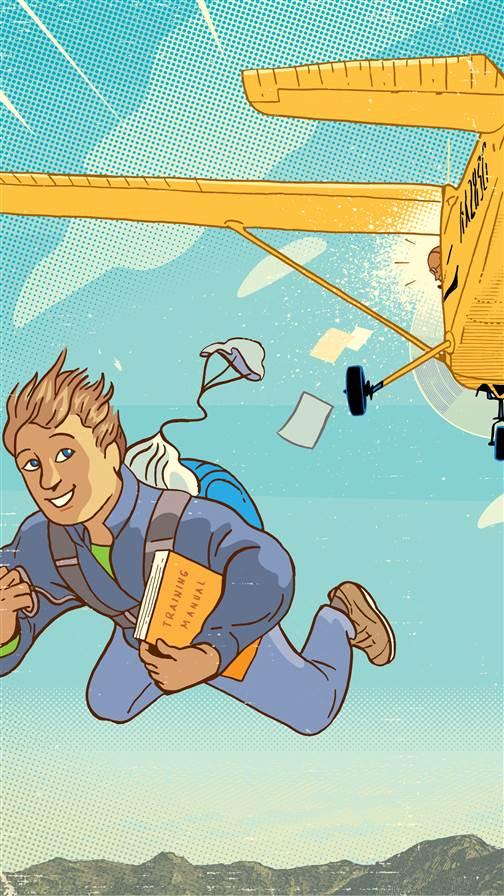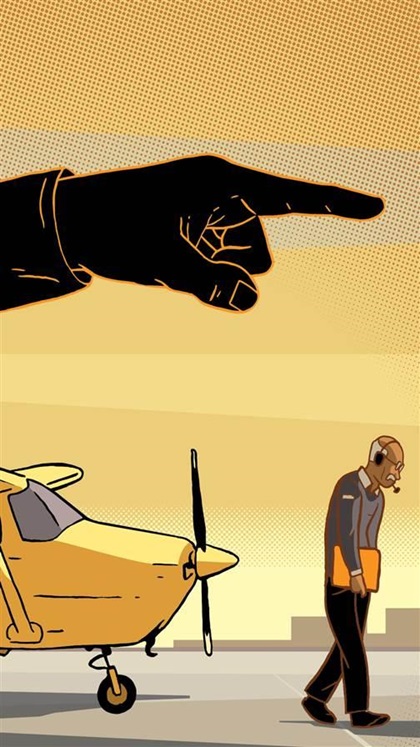You’re (maybe) fired!
How to handle conflict with your instructor
 I was on time but he was running late, and that cascaded to an increasingly harried environment of me being flustered as he barked commands, and him taking more and more control of the airplane when I didn’t respond quickly enough. Finally, on the last landing, he just snatched the controls and taxied back to the terminal so fast I thought we were going to take off.
I was on time but he was running late, and that cascaded to an increasingly harried environment of me being flustered as he barked commands, and him taking more and more control of the airplane when I didn’t respond quickly enough. Finally, on the last landing, he just snatched the controls and taxied back to the terminal so fast I thought we were going to take off.
I’ve been fortunate. Despite flying with dozens of instructors over the years, this one hour stands out as my only bad experience. For the most part, instructors are patient, understanding, and attentive, and they try to keep the student’s needs as a top priority of the instructional process. But instructors are human, and some are rude, inept, careless, or—perhaps the worst instructional sin—indifferent.
How well an instructor behaves is only one side of the equation. The relationship between the student and instructor is nearly as critical. He might be the best instructor in the world, but if he can’t convey the information to the student sitting in the cockpit at that moment, his reputation and overall success are irrelevant. In instructing, the only thing that matters is an individual student’s progress.
I never flew again with the instructor whom I felt was rude, dismissive, and more interested in satisfying an insurance requirement than teaching me anything. And there’s no reason that any student who feels he or she is in a rut should not do the same. If there’s one overriding philosophy of the student-instructor relationship it is this: The student is the boss. He or she is the customer, the one learning, the reason for the flight. The student must drive the business portion of the relationship.
When things start to go wrong in training it can be stressful and de-motivating. What should be a fun and enriching experience can become mired in dread for the next lesson. Hopefully it never gets to that point. And if the relationship is that bad, it’s time to switch. But things are rarely that clear. Often, it’s a feeling that the instructor isn’t up to the task, or that you’re not progressing as fast as you should. To keep the stress of the relationship from taking over your flight training, and to make sure you are getting the most out of your flight training dollar, consider the following easy steps.
Step 1: Analyze the problem
In an emergency the first step is to try and determine the problem. Sometimes it’s easy—the engine quit. And sometimes it’s more difficult—the airplane isn’t climbing as fast as it should be. The student-instructor relationship is no different. First you must analyze the problem, and this too will sometimes be easy—he’s been late for every lesson. But sometimes it’s more difficult—you feel stuck in your progress.
Some of these issues may be clearly coming from the instructor. Lack of skills, lack of empathy, lack of patience, and lack of engagement are good reasons to look elsewhere. But some of the issues could be coming from you.
As part of this process to analyze the potential issues with your relationship you must be honest with yourself about your attitude, your progress, and your commitment. You’ll know you’re ready for the checkride when you can meet the airman certification standards. First solo is a little different. It’s a subjective standard, but if you are consistently making decent landings, can keep things under control in the traffic pattern, perform well on the maneuvers, and can pass a presolo written exam, you are probably ready.
If you’ve thought extensively about the problem and realize you may be contributing to it, consider whether an attitude change or more commitment to the training process will repair your relationship. If you think the issues are primarily with the instructor, it’s time to go to the next step.
Step 2: Have a conversation
Once you’ve focused on the problem, the next step is to have a conversation. Many relationship issues are fixed with communication. It could be as easy as telling your instructor you expect her to show up on time for lessons. Or maybe you’ll have to say something about wanting to make sure you’re on track and that following a syllabus would be helpful. How your instructor reacts to this conversation will speak volumes about any future progress. Most instructors will be receptive to the feedback and appreciative of a student who can express what she needs to be successful.
Whether or not to escalate the concerns to a chief instructor or school owner comes down to personal preference. It is entirely within your right as the student to bring your concerns to the instructor’s boss. Ultimately the feedback will improve the school, and it may improve the instructor. Many people don’t feel comfortable having that sort of conversation, and that’s fine as well.
If speaking to the instructor or his boss didn’t help, it’s time to take action.
Step 3: Fire him
If your conversation or subtle correction didn’t precipitate a change in the instructor, it’s time to move on. There’s no reason to continue to fly with someone who doesn’t have your best interests in mind. If you’re flying at a school with many instructors, this will be an easy process. Go to the chief instructor and ask to be assigned a new instructor. If he or she objects, find a new school. If the instructor retaliates in any way, find a new school. An instructor or school that doesn’t work toward a student’s success shouldn’t receive that student’s business.
Things become a little harder if you’re flying with an independent instructor, but the outcome is the same. Find someone else.
Some students are afraid to switch instructors because they fear a backslide in training. Although it’s true that you will probably have to go on an evaluation flight to see where you currently stand, after an hour or two you should continue progressing forward. Many instructors report flying with a student who had a bad experience at a previous school or with a previous instructor and getting them to solo, or signing them off for the checkride, in just a few hours. This shows that quick progress after an instructor change is possible.
Whatever the circumstance, remember that you are the boss, and if you’re not happy with your progress it may be time to show your instructor the door.
 CFI moves
CFI moves


